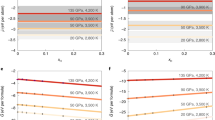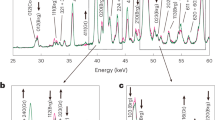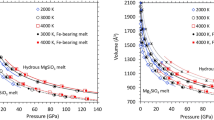Abstract
The presence of water strongly influences the structure, composition and dynamics of the Earth’s deep mantle1,2,3,4. Hydrous magnesium-rich silicates play an important role in transporting water into the deep mantle when oceanic plates subduct as slabs. The highest-pressure form of such hydrous silicates, phase D, was reported to dissociate into an assemblage of nominally anhydrous phases plus water at pressures of about 44 GPa, equivalent to 1,250 km depth5. In this way, free water would be released in the middle region of the lower mantle, which suggests that no water can reach the deeper regions of the lower mantle. Here we use in situ X-ray measurements in conjunction with a multi-anvil apparatus using sintered diamond anvils to show that hydrous phases are stable under lower mantle conditions up to 50 GPa. We found that phase D transforms to an assemblage with another hydrous silicate (MgSiH2O4), named phase H, at pressures above about 48 GPa. Our results suggest that phase H is the dominant hydrous silicate in descending slabs, and may be found at depths far deeper than 1,250 km. We conclude that a significant amount of water is retained in the descending slabs and may be delivered to the deepest part of the lower mantle.
This is a preview of subscription content, access via your institution
Access options
Subscribe to this journal
Receive 12 print issues and online access
$259.00 per year
only $21.58 per issue
Buy this article
- Purchase on Springer Link
- Instant access to full article PDF
Prices may be subject to local taxes which are calculated during checkout




Similar content being viewed by others
References
Inoue, T. Effect of water on melting phase relations and melt composition in the system Mg2SiO4–MgSiO3–H2O up to 15 GPa. Phys. Earth Planet. Inter. 85, 237–263 (1994).
Karato, S., Paterson, M. S. & FitzGerald, J. D. Reology of synthetic olivine aggregates: Influence of grain size and water. J. Geophys. Res. 91, 8151–8176 (1986).
Yoshino, T., Matsuzaki, T., Yamashita, S. & Katsura, T. Hydrous olivine unable to account for conductivity anomaly at the top of the asthenosphere. Nature 443, 973–976 (2006).
Bercovici, D. & Karato, S. I. Whole-mantle convection and the transition-zone water filter. Nature 425, 39–44 (2003).
Shieh, S. R., Mao, H. K., Hemley, R. J. & Ming, L. C. Decomposition of phase D in the lower mantle and the fate of dense hydrous silicates in subducting slabs. Earth Planet. Sci. Lett. 159, 13–23 (1998).
Thompson, A. B. Water in the Earth’s upper mantle. Nature 358, 295–302 (1992).
Komabayashi, T. & Omori, S. Internally consistent thermodynamic data set for dense hydrous magnesium silicates up to 35 GPa, 1600 °C: Implicationsfor water circulation in the Earth’s deep mantle. Phys. Earth Planet. Inter. 156, 89–107 (2006).
Ohtani, E., Litasov, K., Hosoya, T., Kubo, T. & Kondo, T. Water transport into the deep mantle and formation of a hydrous transition zone. Phys. Earth Planet. Inter. 143, 255–269 (2004).
Liu, L. Effects of H2O on the phase behaviour of the forsterite-enstatite system at high pressures and temperatures and implications for the Earth. Phys. Earth Planet. Inter. 49, 142–167 (1987).
Shinmei, T., Irifune, T., Tsuchiya, J. & Funakoshi, K. I. Phase transition and compression behavior of phase D up to 46 GPa using multi-anvil apparatus with sintered diamond anvils. High Press. Res. 28, 363–373 (2008).
Tsuchiya, J., Tsuchiya, T. & Tsuneyuki, S. First-principles study of hydrogen bond symmetrization of phase D under high pressure. Am. Mineral. 90, 44–49 (2005).
Litasov, K. D., Ohtani, E., Nishihara, Y., Suzuki, A. & Funakoshi, K. Thermal equation of state of Al- and Fe-bearing phase D. J. Geophys. Res. 113, B08205 (2008).
Frost, D. J. & Fei, Y. Stability of phase D at high pressure and high temperature. J. Geophys. Res. 103, 7463–7473 (1998).
Shieh, S. R., Mao, H. K., Hemley, R. J. & Ming, L. C. In situ X-ray diffraction studies of dense hydrous magnesium silicates at mantle conditions. Earth Planet. Sci. Lett. 177, 69–80 (2000).
Irifune, T., Kubo, N., Isshiki, M. & Yamasaki, Y. Phase transformations in serpentine and transportation of water into the lower mantle. Geophys. Res. Lett. 25, 203–206 (1998).
Tsuchiya, J. First principles prediction of a new high-pressure phase of dense hydrous magnesium silicates in the lower mantle. Geophys. Res. Lett. 40, 4570–4573 (2013).
Suzuki, A., Ohtani, E. & Kamada, T. A new hydrous phase δ-AlOOH synthesized at 21 GPa and 1000 °C. Phys. Chem. Mineral. 27, 689–693 (2000).
Fukao, Y., Obayashi, M. & Nakakuki, T. Stagnant slab: A review. Ann. Rev. Earth Planet. Sci. 37, 19–46 (2009).
Eberle, M. A., Grasset, O. & Sotin, C. A numerical study of the interaction between the mantle wedge, subducting slab, and overriding plate. Phys. Earth Planet. Inter. 134, 191–202 (2002).
Sano, A. et al. Aluminous hydrous mineral δ-AlOOH as a carrier of hydrogen into the core-mantle boundary. Geophys. Res. Lett. 35, L03303 (2008).
Terasaki, H. et al. Stability of Fe–Ni hydride after the reaction between Fe–Ni alloy and hydrous phase (δ-AlOOH) up to 1.2 Mbar: Possibility of H contribution to the core density deficit. Phys. Earth Planet. Inter. 194–195, 18–24 (2012).
Tsuchiya, T. & Tsuchiya, T. First-principles prediction of a high-pressure hydrous phase of AlOOH. Phys. Rev. B 83, 054115 (2011).
Wen, L. & Helmberger, D. V. Ultra-low velocity zones near the core-mantle boundary from broadband PKP precursors. Science 279, 1701–1703 (1998).
Richards, M. A., Duncan, R. A. & Courtillot, V. E. Flood basalts and hot-spot tracks: Plume heads and tails. Science 246, 103–107 (1989).
Tsuchiya, T. First-principles prediction of the P–V–T equation of state of gold and the 660-km discontinuity in Earth’s mantle. J. Geophys. Res. Solid Earth 108, 2462 (2003).
Stagno, V. et al. The stability of magnesite in the transition zone and the lower mantle as function of oxygen fugacity. Geophys. Res. Lett. 38, L19309 (2012).
Brown, J. M. & Shankland, T. J. Thermodynamic parameters in the Earth as determined from seismic profiles. Geophys. J., R. Astron. Soc. 66, 579–596 (1981).
Acknowledgements
We thank T. Shinmei and T. Inoue for their helpful comments, Kunimoto and F. Isobe for assistance with the experiments. In situ X-ray measurements were conducted at SPring-8 (proposal no. 2013A0082). M.N. was supported by Research Fellowships of the Japan Society for the Promotion of Science for Young Scientists.
Author information
Authors and Affiliations
Contributions
M.N., T.I., J.T. and Y.N. designed the study and wrote the manuscript. M.N. carried out most of the experiments and analyses of the data with the help of Y.T., K.F. and Y.H. All authors discussed the results and commented on the manuscript.
Corresponding author
Ethics declarations
Competing interests
The authors declare no competing financial interests.
Supplementary information
Supplementary Information
Supplementary Information (PDF 656 kb)
Rights and permissions
About this article
Cite this article
Nishi, M., Irifune, T., Tsuchiya, J. et al. Stability of hydrous silicate at high pressures and water transport to the deep lower mantle. Nature Geosci 7, 224–227 (2014). https://doi.org/10.1038/ngeo2074
Received:
Accepted:
Published:
Issue Date:
DOI: https://doi.org/10.1038/ngeo2074
This article is cited by
-
A hydrogen-enriched layer in the topmost outer core sourced from deeply subducted water
Nature Geoscience (2023)
-
Thermal Equation of State of Natural F-Rich Topaz up to 29 GPa and 750 K
Journal of Earth Science (2023)
-
The role of hydrogen bonds in hydrous minerals stable at lower mantle pressure conditions
Progress in Earth and Planetary Science (2022)
-
Deep Earth bound by water
Nature Geoscience (2022)
-
Aluminous hydrous magnesium silicate as a lower-mantle hydrogen reservoir: a role as an agent for material transport
Scientific Reports (2022)



